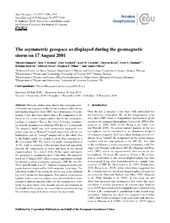| dc.contributor.author | Østgaard, Nikolai | |
| dc.contributor.author | Reistad, Jone Peter | |
| dc.contributor.author | Tenfjord, Paul | |
| dc.contributor.author | Laundal, Karl Magnus | |
| dc.contributor.author | Rexer, Theresa | |
| dc.contributor.author | Haaland, Stein | |
| dc.contributor.author | Snekvik, Kristian | |
| dc.contributor.author | Hesse, Michael | |
| dc.contributor.author | Milan, Stephen Eric | |
| dc.contributor.author | Ohma, Anders | |
| dc.date.accessioned | 2019-06-27T11:44:30Z | |
| dc.date.available | 2019-06-27T11:44:30Z | |
| dc.date.issued | 2018-11-29 | |
| dc.Published | Østgaard N, Reistad JP, Tenfjord PAR, Laundal KM, Rexer T, Haaland SE, Snekvik K, Hesse M, Milan SE, Ohma A. The asymmetric geospace as displayed during the geomagnetic storm on 17 August 2001. Annales Geophysicae. 2018;36(6):1577-1596 | eng |
| dc.identifier.issn | 1432-0576 | en_US |
| dc.identifier.issn | 0992-7689 | en_US |
| dc.identifier.uri | https://hdl.handle.net/1956/20477 | |
| dc.description.abstract | Previous studies have shown that conjugate auroral features are displaced in the two hemispheres when the interplanetary magnetic field (IMF) has a transverse (Y) component. It has also been shown that a BY component is induced in the closed magnetosphere due to the asymmetric loading of magnetic flux in the lobes following asymmetric dayside reconnection when the IMF has a Y component. The magnetic field lines with azimuthally displaced footpoints map into a “banana”-shaped convection cell in one hemisphere and an “orange”-shaped cell in the other. Due to the Parker spiral our system is most often exposed to a BY-dominated IMF. The dipole tilt angle, varying between ±34∘, leads to warping of the plasma sheet and oppositely directed BY components in dawn and dusk in the closed magnetosphere. As a result of the Parker spiral and dipole tilt, geospace is asymmetric most of the time. The magnetic storm on 17 August 2001 offers a unique opportunity to study the dynamics of the asymmetric geospace. IMF BY was 20–30 nT and tilt angle was 23∘. Auroral imaging revealed conjugate features displaced by 3–4 h magnetic local time. The latitudinal width of the dawnside aurora was quite different (up to 6∘) in the two hemispheres. The auroral observations together with convection patterns derived entirely from measurements indicate dayside, lobe and tail reconnection in the north, but most likely only dayside and tail reconnection in the Southern Hemisphere. Increased tail reconnection during the substorm expansion phase reduces the asymmetry. | en_US |
| dc.language.iso | eng | eng |
| dc.publisher | Copernicus Publications | en_US |
| dc.rights | Attribution CC BY | eng |
| dc.rights.uri | http://creativecommons.org/licenses/by/4.0 | eng |
| dc.title | The asymmetric geospace as displayed during the geomagnetic storm on 17 August 2001 | en_US |
| dc.type | Peer reviewed | |
| dc.type | Journal article | |
| dc.date.updated | 2019-03-03T17:51:00Z | |
| dc.description.version | publishedVersion | en_US |
| dc.rights.holder | Copyright 2018 The Author(s) | en_US |
| dc.identifier.doi | https://doi.org/10.5194/angeo-36-1577-2018 | |
| dc.identifier.cristin | 1680171 | |
| dc.source.journal | Annales Geophysicae | |

